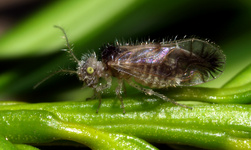Dasydemellidae
Emilie Bess and Kevin P. Johnson


This tree diagram shows the relationships between several groups of organisms.
The root of the current tree connects the organisms featured in this tree to their containing group and the rest of the Tree of Life. The basal branching point in the tree represents the ancestor of the other groups in the tree. This ancestor diversified over time into several descendent subgroups, which are represented as internal nodes and terminal taxa to the right.

You can click on the root to travel down the Tree of Life all the way to the root of all Life, and you can click on the names of descendent subgroups to travel up the Tree of Life all the way to individual species.
For more information on ToL tree formatting, please see Interpreting the Tree or Classification. To learn more about phylogenetic trees, please visit our Phylogenetic Biology pages.
close boxIntroduction
The family Dasydemellidae includes 4 genera and 30 species distributed in North and South America and in Asia. One species, Teliapsocus conterminus, is known from North America and is widespread throughout many regions of the US and southern Canada.Characteristics
Synapomorphies
- Head: Vertex has a pair of concave areas (shared with Amphipsocidae).
- Forewing: hairs have distinctive pattern (see below).
- Hindwing is hairless or has hairs along margin of cell R3 only.
- Female: the external valve of the gonapophyses is well developed.
General Characters
- Head:
- Antennae have 13 segments.
- Vertex has a pair of concave areas.
- Legs:
- Tarsi have 2 segments.
- Wings:
- Forewing:
- Hairs are present on veins on distal half of wing only.
- Hairs on wing veins are in 2 or more rows.
- Forewing has hairs on margin; they do on cross one another.
- Membrane is hairless or has very sparse hairs.
- Pterostigma is shallow.
- Areola postica is free from vein M.
- Hindwing:
- Hindwing is hairless or has hairs along margin of cell R3 only.
- Abdomen: Eversible vesicles (small inflatable sacs) present on underside of abdomen.
- Male: Genitalia are similar to other members of Caeciliusetae:
- Phallosome is closed, the tip has a rough texture.
- Hypandrium is simple, not ornamented, spine on free margin is relatively large.
- Female:
- Subgenital plate lacks posterior lobe.
- Gonapophyses are somewhat reduced:
- Ventral valve is small.
- Dorsal valve is small.
- External valve is well developed.
How to Know the Family
- Large bark lice, 4-6 mm in length.
- Mandibles are large, insects look like their mouths are open.
- Abdomen has eversible vesicles (small inflatable sacs) on underside.
- Wings and body appear hairy.
- Forewing:
- Membrane is hairless or has very sparse hairs.
- Hairs on veins are in 2 or more rows.
- Hairs on margin do on cross one another.
- Pterostigma is shallow.
- Hindwing is hairless or has hairs along margin of cell R3 only.
Family Monophyly
Monophyly of family Dasydemellidae is supported by both morphological and molecular data.
Two synapomorphic morphological characters unite the family: distinctive patterns of hairs on the hindwing and, in the female, the external valve of the gonapophyses is well developed (Yoshizawa 2002). Molecular analysis including two species, Matsumuriella radiopicta and Ptenopsila sp., provides support for the monophyly of family Dasydemellidae (18S nuclear DNA; Johnson et al. 2004).
Discussion of Phylogenetic Relationships
Due to strong morphological similarity between the families Dasydemellidae and Amphipsocidae, there is disagreement as to whether Dasydemellidae should retain status as a family (Mockford 1993) or be included in family Amphipsocidae s.l. (Yoshizawa 2002). Molecular data suggest a sister relationship between Dasydemellidae and Stenopsocidae, and place Dasydemellidae , Stenopsocidae as sister to Amphipsocidae (Johnson et al. 2004).
References
Johnson, K. P., K. Yoshizawa, and V. S. Smith. 2004. Multiple origins of parasitism in lice. Proceedings of the Royal Society of London B 271:1771-1776.
Mockford, E. L. 1993. North American Psocoptera (Insecta). Gainesville, Florida: Sandhill Crane Press.
Yoshizawa, K. 2002. Phylogeny and higher classification of suborder Psocomorpha (Insecta: Psocodea:'Psocoptera'). Zoological Journal of the Linnean Society 136: 371-400.
Title Illustrations

| Scientific Name | Matsumuraiella radiopicta |
|---|---|
| Location | Japan |
| Specimen Condition | Live Specimen |
| Identified By | K. Yoshizawa |
| Life Cycle Stage | adult |
| View | lateral |
| Size | 3mm |
| Copyright | © 2006 Kazunori Yoshizawa |
About This Page
Emilie Bess

Illinois Natural History Survey, Champaign, Illinois, USA
Kevin P. Johnson

Illinois Natural History Survey, Champaign, Illinois, USA
Correspondence regarding this page should be directed to Emilie Bess at and Kevin P. Johnson at
Page copyright © 2009 Emilie Bess and Kevin P. Johnson
All Rights Reserved.
- First online 25 March 2009
- Content changed 25 March 2009
Citing this page:
Bess, Emilie and Kevin P. Johnson. 2009. Dasydemellidae. Version 25 March 2009 (under construction). http://tolweb.org/Dasydemellidae/30392/2009.03.25 in The Tree of Life Web Project, http://tolweb.org/







 Go to quick links
Go to quick search
Go to navigation for this section of the ToL site
Go to detailed links for the ToL site
Go to quick links
Go to quick search
Go to navigation for this section of the ToL site
Go to detailed links for the ToL site